|


|
Marc Mickelson Saturday, September 6
When Doug Schneider and
I discussed our upcoming coverage of CEDIA Expo 2008, we anticipated three or four series
of ShowStoppers. As you can see now that we're finished with our work, there were only two
-- and we had to dig to find all of the products we included. I don't know if it's the
weak economy, the upcoming electron here in the US or just general apathy, but this year's
CEDIA was the least-inspiring of all those I've covered. Attendance was clearly down too,
with the show floor on Sunday afternoon being a veritable consumer-electronics ghost town.
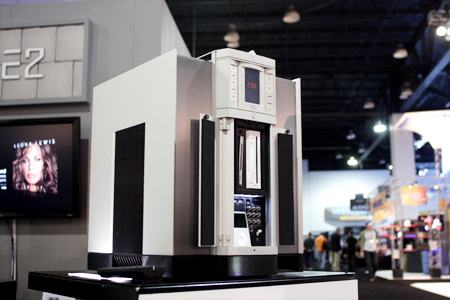
I began this series of short articles talking
about the show through an audiophile's eyes, but as I consider what I saw here, two
home-theater products stick out. The SE2 Labs ITC One
integrated home-entertainment system was just plain cool. This company buys the PC boards
from other companies, then spends 80 hours installing them into a custom chassis that
monitors every operating parameter. Seemingly no detail is ignored. SE2 Labs has even
given a nod to audiophiles by including Wadia's iTransport
as an option.
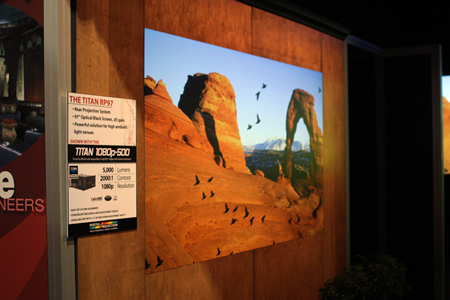
While I have no personal use for the Digital Projection Titan RP97 plasma-replacement system, I admire
the thought that went into it. Replacing a big, heavy and expensive plasma display has to
be a chore, but this system seems about as easy to install as possible and the image
produced is eye-catching, even in bright light.
Well, that's it from CEDIA 2008 in Denver.
We'll be in Atlanta in 2009 -- after the apathy has passed and the economy has improved,
we hope!
Saturday, September 6
The Wadia iTransport appears to be a great success. In case
you don't know what this device is, the iTransport is the only product on the market to
extract the digital datastream from the Apple iPod without modifications, turning the iPod
into a dedicated high-end source component. The iTransport is a nicely made unit and comes
with everything you'll need to use it, right down to the digital cable.
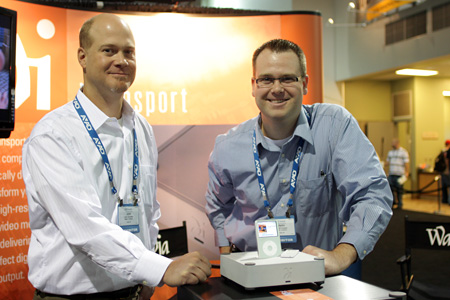
John Schaffer (left) and Martin Cooper of Wadia flank the
iTransport ($379)
While talking with the people from Wadia, however, we found
out about a glitch with the iTransport and Anthem A/V processors, which are unable to lock
on to the iTransport's digital output. The problem is caused by the specification for the
processors' S/PDIF input. Wadia has a workaround, however. Simply buy an RCA-to-XLR
adapter and use the processor's AES/EBU input with the iTransport, as this input has no
such trouble locking on to the iTransport's digital output. This solution also keeps the
S/PDIF input open for other devices.
And if you're wondering about output of the iPod's
graphical user interface (GUI) through the iTransport to a monitor, forget it. The GUI
isn't output from the iPod, even if a particular model can output video. [www.wadia.com]
Friday, September 5
We spent some time at the Sooloos
booth finding out more about this company's innovative music server. The first thing you
will notice about this system is its slick interface, whose visual appeal is only
surpassed by its deep feature set and user friendliness. All around the booth were
touchscreens whose siren's song was too sweet for anyone to resist. You had no choice but
to stop, look, and poke around. The cataloging system seemed simple to navigate, even for
someone who had no experience with it.
However, products such as the Sooloos system raise a big
question for those of us who are indifferent to computer audio: Does such convenience come
at the price of compromised sonics? The answer appears to be yes and no. As a company
representative told us, a basic system -- a terminal and a storage device -- would cost
almost $8000 and provide "sound quality equivalent to that of a $2500 CD
player," which is to say that it would sound good, even very good, but certainly not
commensurate with its cost.
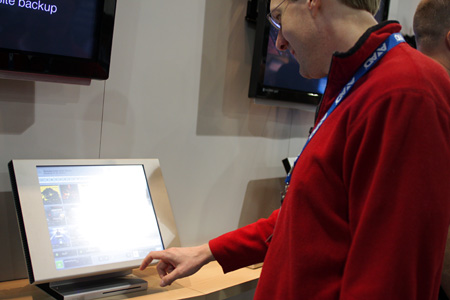
I questioned Peter McGrath of Wilson Audio, an enthusiastic
Sooloos user, about this. He said that an external DAC was necessary to achieving the best
sound from a Sooloos system. He recommended the Audio Research DAC7 on the high end of the
cost scale and a Benchmark Media DAC1Pre on the low end. I also asked Peter to
characterize the improvement wrought by a Sooloos system with an add-on DAC, and he
pointed out a few areas of improvement, including a greater sense of air and ambience as
well as a better transition from the midbass into the bass region. About a demo he
attended that included a Sooloos system used with Audio Research electronics and Wilson
Audio speakers, Peter said, "Everyone could hear the improvement over CD playback
immediately."
I've heard a great deal of top-flight digital equipment, so
I will see if I can get a Sooloos system to write about -- and tell you about. I'll use my
eyes and ears to judge, and I'm open to discovery and being surprised, which is
what all audio writers should demand of themselves.
Thursday, September 4
There isn't much to interest
two-channel audiophiles at CEDIA. The displays are not conducive to listening, even with
all of the music you'll hear wafting around the show floor, and the products are geared
toward a different sort of market. Still, I've been able to keep my audiophile juices
flowing, first with a trip to the showroom of AAudio Imports, which you'll read about in
the "Config.sys" column on SoundStage!, and then with a new version of
a product I've been happily using in my system.
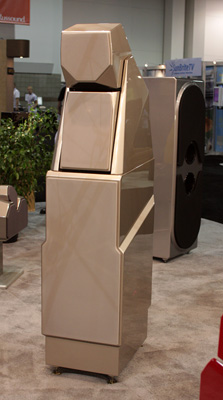 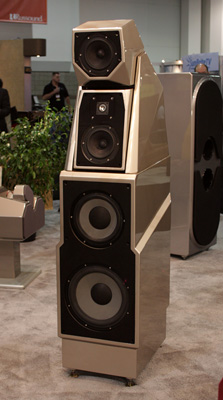
Behold the Wilson Audio MAXX Series 3
($68,000 per pair), which takes a giant leap forward -- and toward Wilson's X-2 Alexandria
-- with its three-piece configuration. The previous versions of the MAXX had a bass
cabinet that housed the woofers and an upper module for the dual midrange drivers and
tweeter. The MAXX 3 splits the upper module into two distinct and separate pieces, and
each is capable of forward-rearward movement as well as rotation. Dubbed "aspherical
group delay," this arrangement allows for precise time-alignment of the speaker's
output. The MAXX 3 also uses a new midrange descended from the driver in the X-2 Series 2,
along with a new tweeter, revised crossovers, and a new cabinet structure. The speaker
still looks like the earlier versions of the MAXX, but also rather different.
The MAXX has always dwelled in the X-2's shadow, but with
the Series 3, it moves out into its own light. That's probably an understatement.
Considering everything that goes into the MAXX 3, this may be Wilson Audio's most radical
remaking of one of its existing speakers. Needless to say, I can't wait to hear a pair. [www.wilsonaudio.com]
|
|
|

